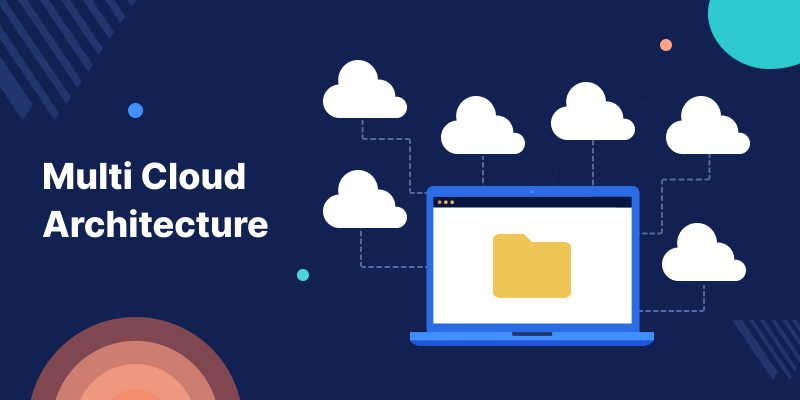Organizations are continuously looking to expand the flexibility and variety of cloud offerings, use the best cloud development services, and cut software development costs.
However, implementing a multi-cloud strategy is not always difficult—”multi-cloud” just means utilizing the benefits of two or more distinct cloud providers to satisfy your expectations.
Therefore, this approach eliminates the need for a single cloud provider or on-premises infrastructure to handle everything.
What is Multi-Cloud?
The term “multi-cloud” refers to a combination of public cloud, hybrid cloud, on-premises, and edge computing.
This approach makes use of many public cloud service providers for compute and storage resources, regardless of whether or not another private cloud or on-premises infrastructure is used.
A hybrid cloud refers to a multi-cloud deployment that comprises a private cloud or on-premises infrastructure.
Benefits of Using a Multi-Cloud Environment
The following are some of the benefits of using a multi-cloud platform –
- If a company does not want to commit to employing a single cloud vendor for all of its infrastructure needs, then it can pick and select the most cost-effective services from various providers.
- If one cloud fails in a failover scenario, then companies with a multi-cloud strategy can fall back on others. When a company employs numerous clouds for data sovereignty or in conjunction with a CDN service, the latency is minimized because the clouds are closer to the end users.
- If hackers gain access to one set of data, in that case, firms are more likely to recover if they can restore it from a distinct network-based cloud environment.
- When you use a multi-cloud strategy, you can work with providers who specialize in one area and do it well rather than doing everything on average.
- If your users are dispersed throughout the globe, then choosing various cloud providers based on proximity can help them perform better.
Limitations of Using a Multi-Cloud Environment
Some limitations of using a Multi-Cloud environment are –
- Interfacing with several providers, each with their processes and technology is required for a multi-cloud deployment. It might also be difficult to integrate services from different platforms.
- The larger your attack surface becomes as you add more cloud providers to your multi-cloud strategy. You’ll also need to design security rules for each cloud platform because each has its own set of complexities.
- If services in many clouds need to communicate with one another to satisfy user requests, latency may be introduced, depending on how tightly the clouds are linked, how far apart the data centers are physically, etc.
- It’s tough to balance loads across multiple clouds, especially if the data centers are spread out across the country.
How to Manage a Multi-Cloud Environment?
Here are a few things to consider while putting together a multi-cloud environment –
- To minimize system complexity and poor resource usage, analyze your complete network and then determine which cloud provider’s service is ideal for your specific requirements.
- With various cloud providers, low-level maintenance as well as monitoring tasks become more difficult. So, it is preferable to have them automated.
- Focus on policy standards that are applied to each cloud environment automatically. And data storage, workloads, traffic flows, virtual servers, compliance/regulations, security, and reporting are all covered by the policies.
- Determine which apps in your company are most suited for a multi-cloud scenario. Cloud-native apps are based on a scale-out architecture and are flexible and service-oriented, consisting of collections of containers and services.
- Use a virtual data center management system with an integrated data center management system. Therefore, it helps with the development of a system in which your server, operations, security, and applications teams collaborate to achieve common objectives.
Multi-Cloud vs Hybrid Cloud
Let’s discuss certain comparisons between the clouds –
| Hybrid-Cloud | Multi-Cloud |
| Multi-cloud may include Hybrid-Cloud Approach | It connects to various public clouds. |
| Helps in the creation of a single, flexible, and cost-effective IT infrastructure. | Utilizes the most advanced cloud technologies available |
| In most cases, the components of a hybrid cloud work together. | Different clouds take care of different tasks. |
| As needed, the cloud will burst. | It is Highly Scalable |
| In terms of initial capital and architectural setup, it is costly. | Relatively, less expensive |
| A hybrid cloud may not have a Multi-Cloud approach | Multi-Cloud may include Hybrid-Cloud Approach |
| Store sensitive data on-premises or in private clouds, and assume full security responsibility. | The CSP manages its cloud infrastructure but the client manages data and service configurations |
Conclusion
In short, Organizations can establish secure and powerful cloud environments outside of traditional infrastructure thanks to a multi-cloud architecture.
However, the basic purpose of a multi-cloud strategy is to use as many clouds as needed to overcome the restrictions of using a single cloud provider.
Although switching between cloud providers to complete tasks can be difficult, particularly at first, cloud service providers are attempting to make switching between clouds more effective.
Therefore, Multi-cloud computing will become more common as it becomes more efficient.
For Magento 2 Elastic search, please follow –
Our Cloudkul Blogs
Elasticsearch, Fluentd, and Kibana (EFK)
Setting up Elasticsearch, Logstash, and Kibana for centralized logging
Managing and Monitoring Magento 2 logs with Kibana
Our store modules –
You may also visit our Magento development services and quality Magento 2 Extensions.
For further help or queries, please contact us or raise a ticket.
